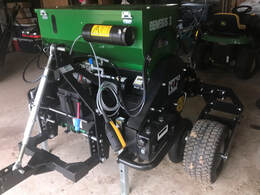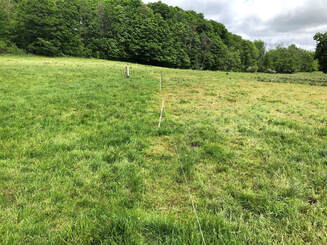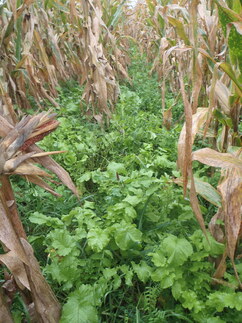CONSERVATION CORNER
A weekly blog for all things conservation
 By: Kevin Brown, Ag Resource Specialist, BCCD You haven’t? Then you just don’t know what kind of soil you are dealing with, do you? This is really a neat little experiment to see just how good your soil really is. How healthy is it? I have written a number of articles about soil health, as you may well know, and this is one way to determine how good your soil is.
0 Comments
 I have written many times about soil health- why we need it, why we should care, what it takes to get it, etc. I won’t bore you with too many of those details in this article, but one of the principles of soil health is “do not disturb the soil”. This is the reason that I talk about no till gardens, no till cropping practices, cover crops, and the list goes on. The soil is home to hundreds of thousands of organisms per teaspoon, if you have good soil health. If you are one that “needs” to plow/rototill/etc., you are essentially completely destroying those organisms’ homes. It is no different that a major hurricane coming through some ocean front town on the coast. All these beneficial organisms have built their homes in the open spaces in the soil. We need to leave them alone as much as possible for them to stay and do the good things that they do.  See, I know how to put in a title that will get your attention. Now that I have it, I will tell you that we may have funds that can help you out. No, we can’t help with any of the everyday things. We are the Conservation District. Our job revolves around clean water. Mine, in particular, has to do with the Ag sector. However, we do have people down here that specialize in stream issues and forestry and such. Streams, as most of you are aware, are a whole different topic and very hard to explain what we can and can’t do. I will leave that to someone else. We live in a very unique area with unique topography. It is complicated.  By: Sarah K. Xenophon, Kristen Koch, and Jennifer R Fetter; Penn State Extension One of the many visual indicators you might use to assess the health of a stream is the amount of stream bank vegetation and other cover. You might find yourself walking along a stream or river, either on your property or when visiting a park or your local woods, and wish you had an easy way to understand the health of that stream. One indicator of stream health is the condition of the stream bank cover. When we talk about stream bank cover, or simply bank cover, we are talking about how much of the soil immediately adjacent to the water is covered by growing vegetation, stable debris, or bedrock material. This helps determine the health of a stream because it can tell us a lot about the relative stability of that stream. A stable stream maintains the same shape and flow pattern over time. A healthy, stable stream typically has more bank cover than an unhealthy stream. Bank cover helps reduce erosion by reducing the amount of soil exposed to passing water as it rushes into and down the stream. The stability of a stream is vital for any organisms that live in and around the stream and for protecting your property and nearby infrastructure (driveways, sewer lines, bridges, and more).  Kevin Brown, Ag Resource Specialist, BCCD So you have animals, or you want to get some. You may have 1-2 acres that you can put them on, or you may have 10 acres. To most people, when they look at that much land, they think “That is a lot of land and it will support however many animals I want to have”. Let’s be honest, 3-5 horses on one full acre of ground doesn’t look like much. Neither does 15 cows on a full 10 acres of land. So, you get the number of animals you want and start a farm. All is well. The animals have plenty enough land to roam on. They are comfortable and happy. And when you start supplementing them with hay, you don’t think anything about it. That is how it is supposed to be. Right? Well, no, not really. Not for you or the environment.  By: Kevin Brown, Ag Team Leader I was struggling for a good topic this week when I guy walked in and started asking me about reseeding a field. How to do it, what he should use, etc. I think there are still enough people out there making hay on a lot of Bradford County fields so I will hit that topic this week. First off, we need rain! For non-farmers, how could you ask for a better year? Warm, dry, just beautiful weather. For farmers and gardeners, not so much.  By: Kevin Brown, Agricultural Team Leader Are you one of those homeowners that have very difficult areas to mow? A bank? A ditch? A wet area? Around trees and obstacles in the lawn? Have you evaluated all the alternatives (not that there are really that many) to deal with this? We could still find a way to get it mowed. This alternative keeps it looking good, but it takes some effort. We could just let it go, and who wants to do that? It looks ugly (to us), right? Or we could just spray it and kill what is there. That sounds like the easiest way to deal with it. No hard work. You only have to do it once (probably). However, do you understand all the ramifications with this option? I am not going to get into the debate of whether sprays are harmful to the environment or not. That is for another time. What I do want to do is give you some cold hard facts about some of the results of doing this.  Kevin Brown, BCCD, Ag Team Leader So, it is that time of year again. Time to let the animals out to pasture. No more feeding them stored forages that you had to make. No more catering to their every whim. Now, they can be let out and go take care of themselves. Well, at least for a short period of time. We like to say that we are “pasturing” our animals, but are we really? Yes, there are some that are, and do a really good job of it. However, opening the gate and letting them roam free on the same pasture for the next 6-7 months is not pasturing. That is an exercise lot. Yea, there may be some grass growing there originally, but unless you have an expansive pasture, that goes away fast. And even if you have a big enough lot that you don’t have to feed them any stored forages, you really aren’t doing the best thing for any of the resources you have. I will try to give you some information on some of the things going on with this style of “pasturing” that you may not know. It could make you a lot more money.  By: Kevin Brown, BCCD In case you missed last week’s meeting, I will give a quick overview of some of the information that was gone over at the meeting. First off, ANYONE that owns a farm animal needs to have a Manure Management Plan. Period. One chicken, one cow, one horse, etc. Now before you go getting all jacked up, it is easy as pie to do. We all know of an operation somewhere that only has a few animals and they are having a huge impact on the stream. (That’s PC for what’s really going on). This is why it applies to anyone having a farm animal. Now, if you want to write the plan yourself, go to www.paonestop.psu.edu and you have the ability to write your own plan. You do not need to send it in anywhere. No one needs to verify it. You just keep it, and keep records on where your manure goes. If you have any questions, contact me and I will help you work through it. For an operation with only a few animals, it won’t take long at all. And, if DEP or the Conservation District stops for any reason, it will be the first thing they ask for. It is law.  By Kevin Brown- BCCD, Ag team Leader If you are a regular reader of the column, or you have read something that sparked your interest, or you just disagree with something you have read, here is your chance to talk about it. We have received a grant to hold two meetings to talk about a lot of the conservation practices that we continually talk about and promote. I am going to structure the meetings to be more informal where we can listen to each other and find out what experiences other locals have had. There are a lot of people out there that are a lot smarter than I am and they have maybe done things a certain way for a long period of time and have been very successful at it. Why wouldn’t we want to hear from them? If you would like to be one of “them”, or if you want to hear from “them”, make plans to be there. I think we have plenty of great topics to talk about. |
AuthorsVarious staff at the Bradford County Conservation District Archives
July 2024
Categories
All
|
|
Bradford County Conservation District
Stoll Natural Resource Center 200 Lake Road, Suite E | Towanda PA 18848 Phone: (570)-485-3144 |
